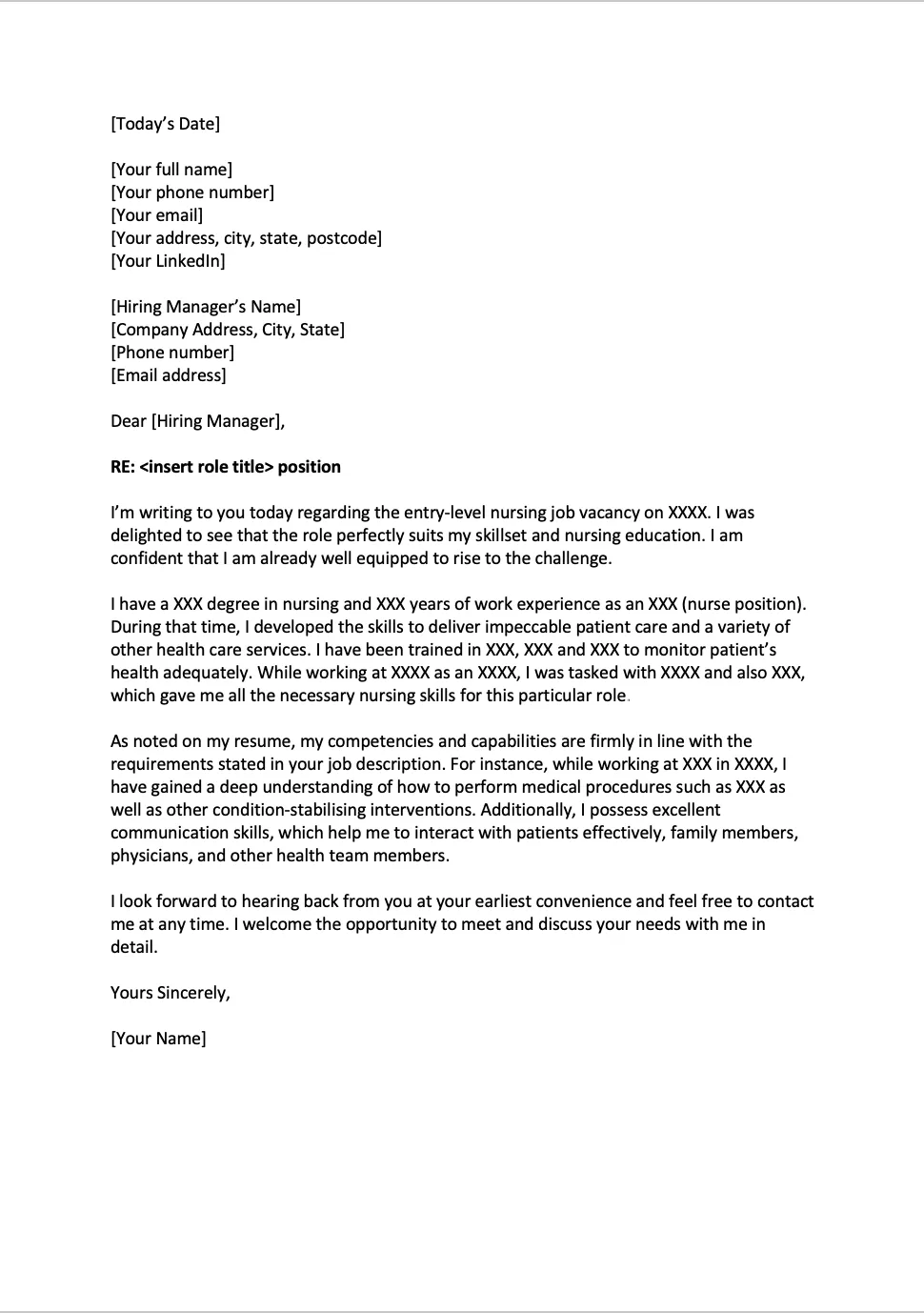Why You Need a Nursing Cover Letter
In the competitive world of nursing, a well-crafted cover letter is your first impression. It serves as a vital tool to showcase your skills, experience, and personality, setting you apart from other applicants. Unlike a resume, which provides a factual overview of your qualifications, a cover letter allows you to tell your story and demonstrate why you’re the perfect fit for the specific nursing job. It gives you the opportunity to connect with the hiring manager on a more personal level, expressing your enthusiasm and detailing how your skills and experiences align with the job requirements. Ignoring a cover letter could mean missing an opportunity to highlight your unique strengths and passions for the role, making you less likely to secure an interview.
Key Components of a Nursing Cover Letter
A strong nursing cover letter consists of several key components working together to make a compelling case for your candidacy. From the header to the closing, each element plays a crucial role in capturing the hiring manager’s attention and conveying your suitability for the role. These sections are designed to be clear, concise, and tailored to the specific job you’re applying for. By thoughtfully crafting each component, you can create a cover letter that effectively highlights your qualifications and increases your chances of landing an interview.
Header Information
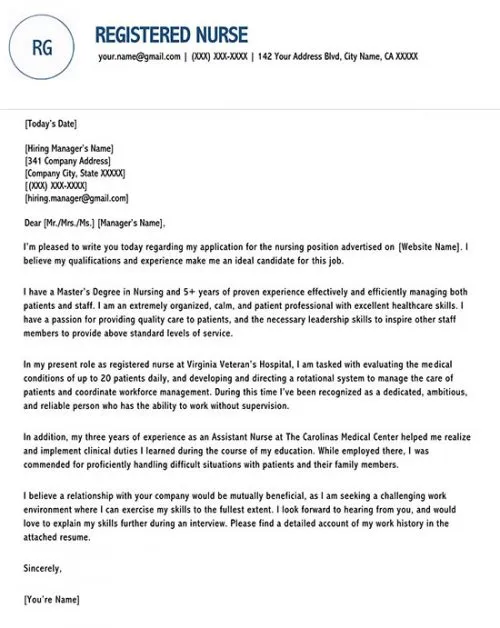
The header of your cover letter should clearly present your contact information and the date. Accuracy and professionalism are vital here, as this information facilitates easy communication and demonstrates attention to detail.
Applicant’s Contact Information
Include your full name, phone number, professional email address, and optionally, your LinkedIn profile URL. Ensure your email address is professional and appropriate.
Date
Place the current date below your contact information. This indicates when the letter was written.
Hiring Manager’s Contact Information
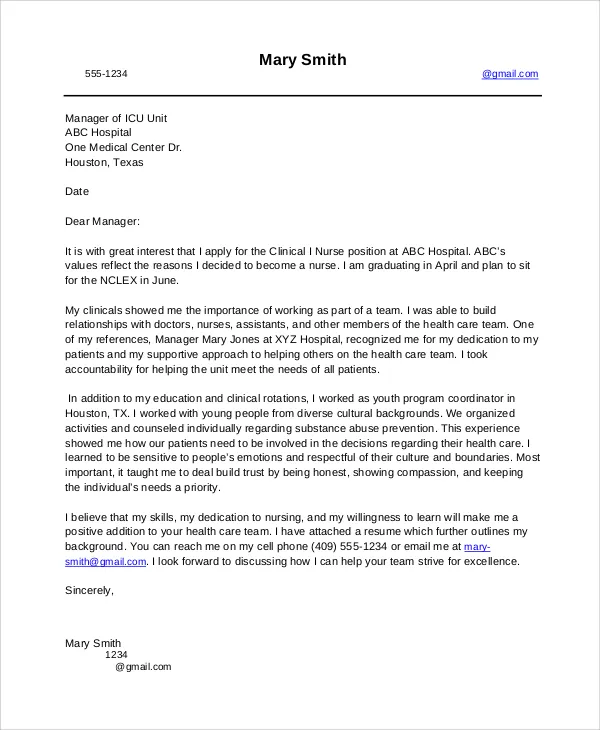
If possible, find the hiring manager’s name and title. Addressing the letter to a specific person shows you’ve done your research and increases the personal touch. Include the hiring manager’s title, the company name, and the company’s address.
The Salutation
Start with a professional salutation, such as “Dear Mr./Ms./Dr. [Last Name],” if you know the hiring manager’s name. If not, use a general greeting like “Dear Hiring Manager.” Avoid outdated salutations such as “To Whom It May Concern.”
Body Paragraph 1: Introduction
The introduction is your opportunity to grab the reader’s attention. State the position you are applying for and how you learned about the opportunity. Briefly introduce yourself and express your enthusiasm for the role and the organization. This sets the tone for the rest of your letter and gives the hiring manager a clear understanding of why you are writing.
Express your interest

Clearly state the specific nursing position you are applying for and where you found the job posting. This immediately informs the hiring manager of your intentions and shows you’ve followed instructions. Show enthusiasm for the role and the organization to make a positive initial impression.
Highlight your experience
In this paragraph, provide a brief overview of your relevant experience. Focus on the aspects of your background that align with the job requirements. Mentioning key skills or accomplishments quickly gives the reader a sense of your capabilities and value. This sets the stage for a more detailed discussion of your qualifications later in the letter.
Body Paragraph 2: Skills and Qualifications
This is the core of your cover letter, where you demonstrate how your skills and experiences match the job requirements. Use this section to provide specific examples of your achievements and how you have excelled in past roles. Tailor this section to each job you apply for, ensuring you highlight the skills and experiences that are most relevant to the role. This helps the hiring manager understand your potential to succeed.
Showcasing relevant skills
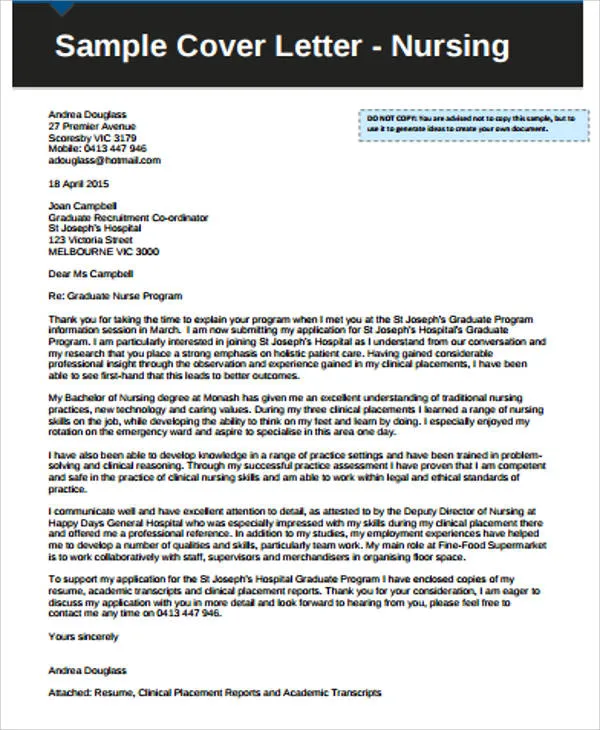
Identify the key skills the employer is looking for. Then, describe your experiences where you used these skills. Use action verbs to show what you achieved. Give examples of how you’ve applied your skills to successfully handle patient care, manage medical situations, and collaborate with healthcare teams.
Quantifying your achievements
Whenever possible, use numbers or data to quantify your achievements. For example, you could mention how you improved patient outcomes, reduced errors, or increased efficiency. Using quantifiable data to back up your claims provides solid evidence of your contributions and adds significant credibility to your application.
Body Paragraph 3: Closing
Conclude your cover letter with a professional closing statement. Express your gratitude for the opportunity and reiterate your interest in the position. Also, include a call to action, such as inviting the hiring manager to contact you for an interview. This section helps ensure a positive and memorable conclusion.
Expressing gratitude
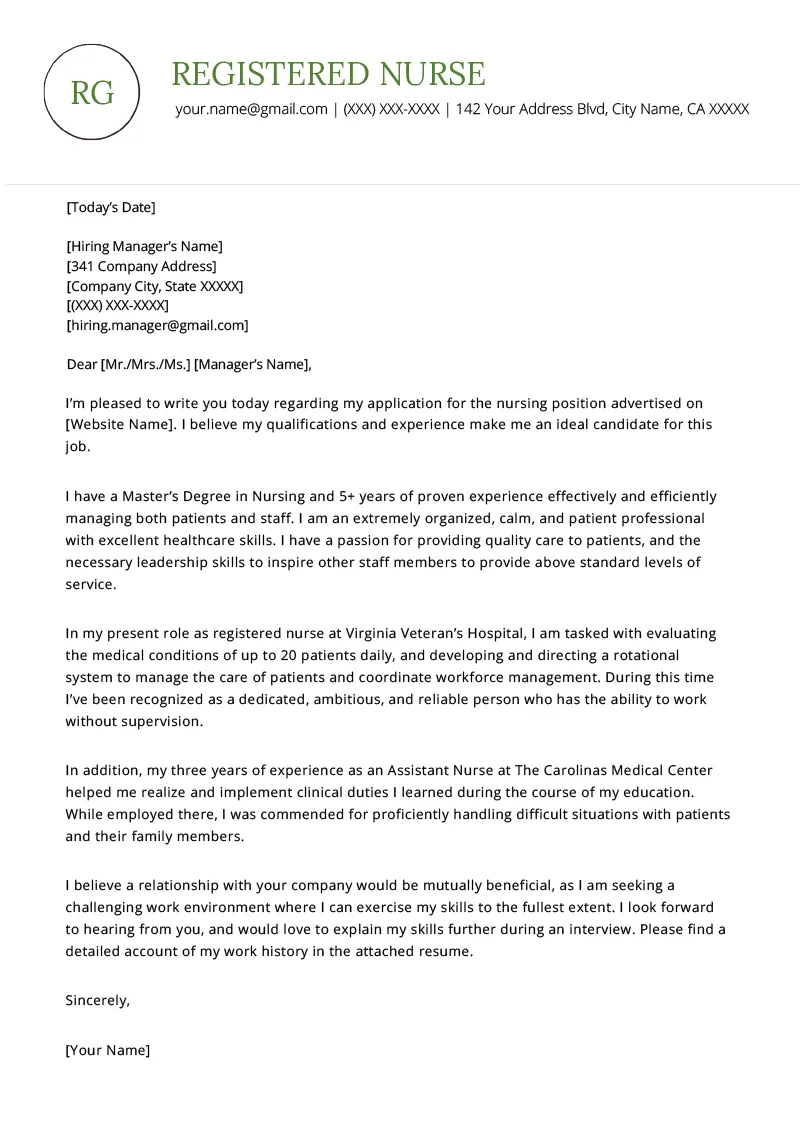
Thank the hiring manager for considering your application. Show appreciation for their time and the opportunity to be considered for the position. This demonstrates professionalism and respect for the hiring process.
Call to action
End with a call to action. This is a clear request to the hiring manager. State your availability for an interview and provide your contact information once more. This final touch indicates your enthusiasm and willingness to move forward in the hiring process.
Formatting Your Nursing Cover Letter
Formatting your cover letter is just as important as its content. The overall appearance of your letter reflects your professionalism and attention to detail. Ensure your cover letter is visually appealing and easy to read. Use appropriate fonts, spacing, and margins to present your information clearly and effectively. Well-formatted content makes it easy for the hiring manager to read and review your qualifications.
Font selection and size
Choose a professional font like Times New Roman, Arial, or Calibri. Keep the font size between 10 and 12 points. A readable font and size enhance the readability of your cover letter, making it easier for the hiring manager to quickly scan and understand your key points.
Line spacing and margins
Use single or 1.15 line spacing and set 1-inch margins on all sides. Proper spacing ensures your letter is visually balanced and easy on the eyes, avoiding a cramped or sparse appearance. This promotes better readability and enhances the overall presentation of your application.
Proofreading and editing
Always proofread your cover letter carefully. Check for any spelling, grammar, and punctuation errors. Have someone else review it as well. A polished cover letter shows that you pay attention to detail. Making sure your cover letter is free of errors demonstrates professionalism and your attention to detail. Proofreading is an essential step to making a great first impression.
Tailoring Your Cover Letter for Different Nursing Roles
Your cover letter should be tailored to the specific nursing role you are applying for. Highlight skills and experiences that align with the job’s requirements and use language that reflects the specific responsibilities. This customized approach shows that you understand the needs of the position and are a strong fit for the job.
Registered Nurse (RN) cover letter
Focus on your clinical skills, patient care experience, and any specializations or certifications you have. Mention your experience in different healthcare settings, your ability to work as part of a healthcare team, and any leadership roles you’ve taken on. Highlighting these elements is essential in proving your readiness and fit for an RN role.
Licensed Practical Nurse (LPN) cover letter
Emphasize your patient care skills, experience with medication administration, and your ability to follow medical protocols. Show that you are a compassionate and reliable team player. Mention your experience in providing direct patient care and any specific areas of expertise. This targeted approach highlights your practical nursing skills.
Nurse Practitioner (NP) cover letter
Highlight your advanced clinical skills, your ability to diagnose and treat patients, and your experience in a specific area of healthcare. Include your certifications, any specializations, and your experience in leadership or management roles. Focus on your ability to provide advanced patient care and your capacity to work independently.
Common Mistakes to Avoid
Avoiding common mistakes can significantly improve your chances of success. Be careful about the use of typos, generic cover letters, and exceeding the one-page limit. A well-crafted cover letter should always be free of errors and personalized for each job. Correcting these common mistakes will improve your application and give you a significant advantage.
Typos and grammatical errors
Always proofread your cover letter for any spelling, grammar, and punctuation errors. Errors can make you appear careless and unprofessional. Using spellcheck and proofreading tools helps, but have someone else review it as well.
Generic cover letters
Do not use a generic cover letter. Customize your letter for each job application, highlighting skills and experiences relevant to that specific role. Generic letters do not demonstrate your genuine interest or commitment to the position, and they make it harder to stand out.
Exceeding the one-page limit
Keep your cover letter concise and generally to one page. Hiring managers have limited time. A well-written, concise letter is more effective than a long, rambling one. Make sure your most important points are presented first.
Cover Letter Examples
Review examples of effective nursing cover letters to guide your writing. These examples can help you visualize the structure, tone, and style of a successful cover letter. Adapt the examples to reflect your unique skills and experience.
